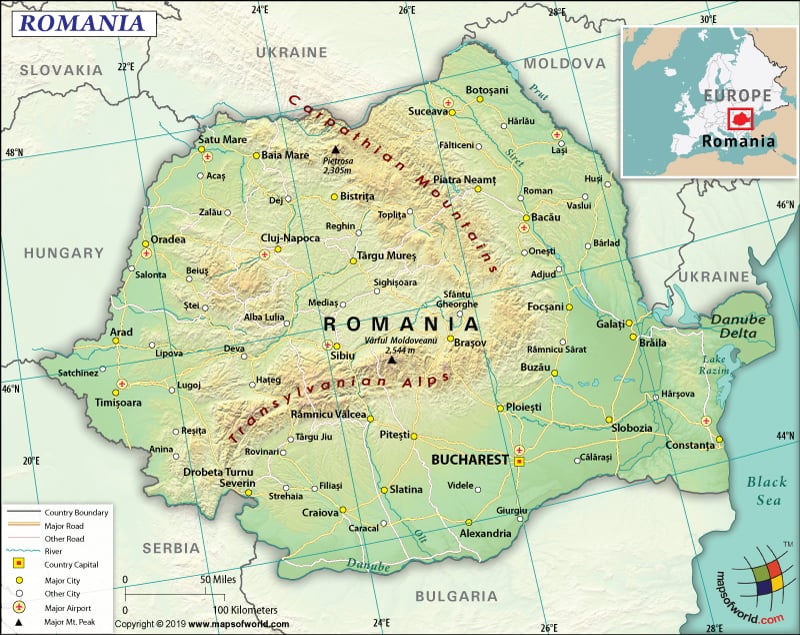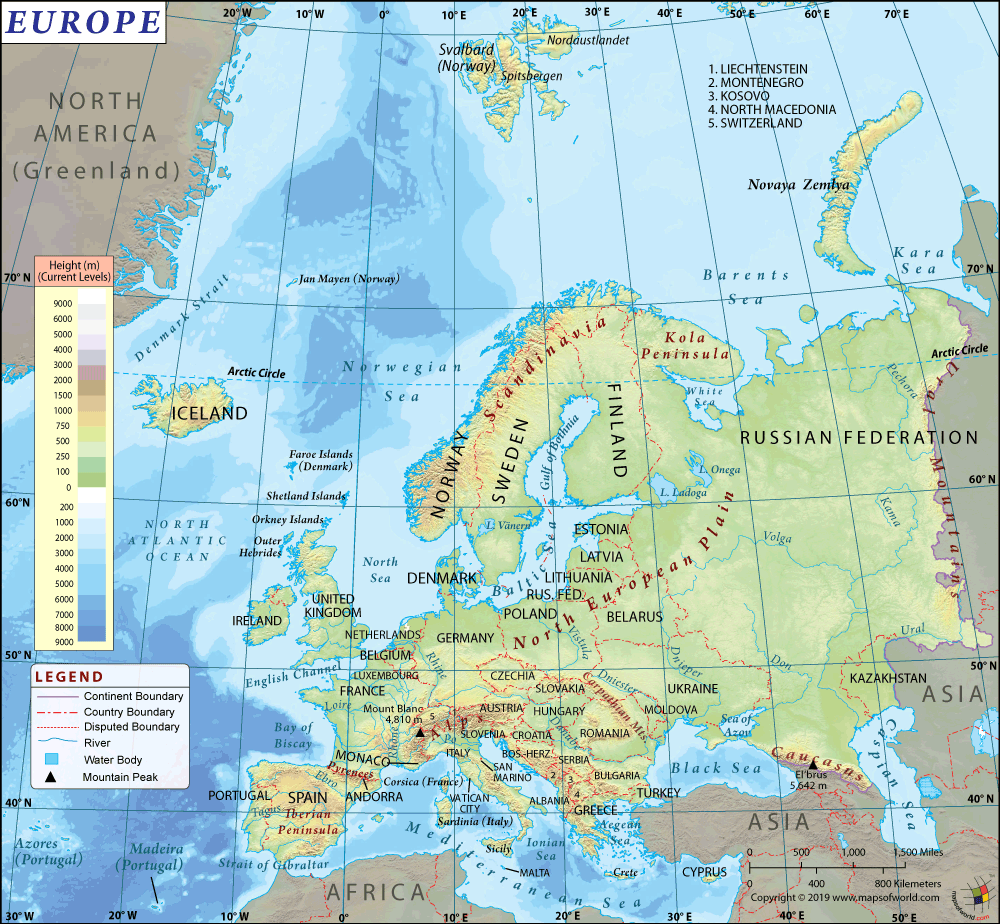What are the Key Facts of Romania?

|
Official Name |
Romania |
|
Continent |
Europe |
|
Capital |
Bucharest |
|
Largest City |
Bucharest |
|
Coordinates |
46.000000, 25.000000 |
|
Area |
92,046 sq. mi (238,397 sq. km) |
|
Land Boundaries |
1,767 mi ( 2,844 km) |
|
Coastline |
140 mi ( 225 km) |
|
Currency |
Romanian Leu (RON) |
|
Neighboring Countries |
Moldova, Ukraine, Hungary, Serbia, Bulgaria |
|
Population |
19,401,658 (2019 est. ) |
|
Official Languages |
Romanian |
|
Major Religion |
Christianity |
|
National Day |
1 December (Unification Day) |
|
National Anthem |
“Desteapta-te romane!” |
|
Form of Government |
Unitary semi-presidential republic |
|
President |
Klaus Iohannis |
|
Prime Minister |
Ludovic Orban |
|
GDP per capita (PPP) |
$ 28,206.4 (World Bank, 2018) |
|
GDP per capita (nominal) |
$ 12,301.2 (World Bank, 2018) |
|
HDI |
0.811 (2017), Rank: 52 |
|
Literacy Rate (%) |
98.84 % (UNESCO, 2018) |
|
Space Agency |
The Romanian Space Agency (ROSA) |
|
Military Expenditure Ranking |
41 (SIPRI, 2017) |
|
No. of Olympic Medals |
307 (as of 2018) |
|
Driving Side |
right |
|
Calling Code |
+40 |
|
Time Zone |
UTC+2 (EET), Summer (DST) UTC+3 (EEST) |
|
Internet TLD |
.ro |
Where is Romania?
Romania is in Southeastern Europe between Ukraine and Bulgaria, bordering the Black Sea. It is located around halfway between the North Pole and the equator. This country is bordered by Moldova to the east, Serbia to the southwest, Hungary to the west, Ukraine to the north, Bulgaria to the south, and the Black Sea to the southeast.
What is the Geography of Romania?
Romania is spread across a total land area of 238,397 sq. km (92,046 sq. mi), out of which 229,891 sq. km (88,761 sq. mi) is land area and 8,500 sq. km (3,282 sq. mi) is water area. It has a 2,844 km (1,768 mi) long land boundary and a coastline of 225 km (140 mi).
The land border of Romania is shared with five countries: Moldova (683 km or 424 mi), Bulgaria (605 km or 374 mi), Ukraine (601 km or 373 mi), Serbia (531 km or 330 mi), and Hungary (424 km or 263 mi).
The terrain of Romania is evenly divided among plains, hills, and mountains. The mean elevation of the country is 414 m (1,358 ft). The mid-sized Carpathian Mountain extends through the country’s central part in a wide arc. This mountain is the source of many rivers. A range of the Carpathian Mountain called the Transylvanian Alps divides Romania into the central and southern parts.
Mount Moldoveanu, the highest elevation point of the country at 2,544 m (8,346 ft), is located on the Transylvanian Alps. The land beyond the Carpathian foothills slopes down into rolling hills as well as plains. The Romanian Plain is in Craiova’s south. It is a low-lying plain that extends to the eastern direction to the Black Sea.
The Black Sea is the lowest elevation point of Romania at 0 m (0 ft). However, the lowest land area of the country is located along the Danube Delta, which is an area full of sandbanks, floating reed islands, and an area of marshes.
A large part of the southern borders along Bulgaria and Serbia is formed by the delta of the Danube River, which travels around 1,075 km (668 mi) along the territory of Romania. The Danube is the longest river in Europe, traveling around 2,850 km (1,771 mi) from Germany’s Black Forest in the southeast direction.
Other major rivers in Romania include Ialomita, Dambovita, Arges, Somes, Siret, Prut, Olt, Mures, Jiu, etc. While the Prut River flows along the Moldovan border in the east, the Danube River flows along the Bulgarian border in the south. The Danube River flows in the north and east to end in the Black Sea.
Around 3,500 lakes (including lagoons, glacial lakes, volcanic lakes, natural dam lake, and coastal lakes) of small-to-medium sizes are present in the country. Some of the major ones are Zanoaga, Bucura, Razim, Sinoe, Brates, Oltina, Lake St. Ana, Red Lake, etc.
Romania has a temperate-continental climate, which has four distinct seasons. The summers are hot, the winters are cold, the autumns are cool and dry, and the springs are foggy and mild. A regional climatic variation can be found in the country because of the presence of the Danube Delta and the presence of the Carpathian Mountains in the central parts of the country. All round the year, the level of precipitation is generally moderately low. The mountainous regions as well as in the west, the amount of rainfall is higher than that of the eastern regions (which are comparatively drier). Winters are milder in the western regions.
What is the Economy of Romania?
The nominal GDP of the Romanian economy grew at the rate of 4.096% in 2018 to reach a figure of US$ 239.553 billion. Romania is considered by the World Bank as a high-income country, which has a mixed economy.
The major export items are cars, vehicle parts, rubber tires, refined petroleum, insulated wires, etc. The import items of Romania are insulated wires, crude petroleum, packaged medicaments, cars, vehicle parts, etc. While the value of exports was US$70.5 billion, the value of imports was US$81.4 billion in 2017. It resulted in a negative balance of trade of over US$10.9 billion.
In 2018, the rate of unemployment was 4.3%, a drastic fall from 8.11% in 2002. The country suffers from a high level of poverty. Around 40% of the population was at the risk of poverty in 2016. This rate is one of the highest among the European Union countries. One of the main reasons for this is the high level of inequality in Romania (which was at level 7 in the inequality index in 2017). Housing problems, widespread child poverty, and poverty in rural areas are the main economic problems of the Romanian economy.
What is the Transportation System of Romania?
Romania has 84,185 km (52,310 mi) long roadway, out of which 49,873 km (30,990 mi) is paved and 34,312 km (21,320 mi) is unpaved. An extensive railway network is present in Romania. Over 11,268 km (7,002 mi) long railway network is present in the country, out of which 10,781 km (6,699 mi) is standard-gauge, 427 km (265 mi) is narrow-gauge, and 60 km (37 mi) is broad-gauge.
Romania has an extensive navigable waterway, which is 1,731 km (1,076 mi) long. Most of the waterway navigation takes place on the Danube River (1,075 km or 668 mi). The rest of the waterway navigation takes place on secondary branches (524 km or 326 mi) and on canals (132 km or 82 mi).
There are 45 airports in Romania, out of which 26 have paved runways and 19 have unpaved runways. Two heliports are also there. Some of the major airports in the country are Bucharest “Henri Coandǎ” International Airport, Bacău “George Enescu” International Airport, Baia Mare Airport, Constanța “Mihail Kogălniceanu” International Airport, Oradea International Airport, Iași International Airport, Suceava “Ștefan cel Mare” International Airport, Timișoara “Traian Vuia” International Airport, etc.
What International Organizations is Romania part of?
WTO, WHO, IMF, ILO, UNESCO, NATO, NSG, Australia Group, BIS, BSEC, CD, CE, CEI, EAPC, EBRD, ECB, EIB, ESA, EU, FAO, G-9, IAEA, IBRD, ICAO, ICCT, ICRM, IDA, IFAD, IFC, IFRCS, IHO, IMO, IMSO, Interpol, IOC, IOM, IPU, ISO, ITSO, ITU, MIGA, MONUSCO, OIF, OPCW, OSCE, PCA, SELEC, UN, UNCTAD, UNHCR, UNIDO, Union Latina, UNMIL, UNMISS, UNOCI, UNWTO, UPU, WCO, WIPO, WMO, ZC, CBSS (observer), ICC (national committees), ITUC (NGOs), LAIA (observer), OAS (observer), WFTU (NGOs)
Related Links:
Related Maps:


9250 total views , 3 views today